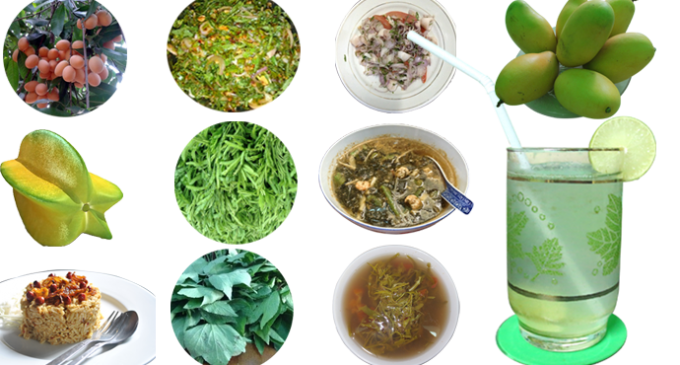Fancy something sour?

So much so is the love for sour things by Myanmar people that the instance they talk about sour fruits like green mangoes, ripe marian and sour plum their mouth start to water. And there are so many kinds of sour fruits, vegetables and dishes available in every season in the country to cater to the Myanmar people’s passion for sour taste.
There are the fruits which taste sour when eaten raw or ripe, fresh or preserved. A variety of fruits would come into our mind when we think of sour food. First would be the monarch of all fruits – mango. There are about 300 varieties of mangoes in Myanmar which is one of the two countries from which it originated. Some varieties become sweet when they ripen and some remain sour even when they ripen. Next would be lemon and other members of the citrus family. The third would be marian, which turns orange when it ripens. There are two varieties, the sweet type which becomes sweet when it ripens and the sour variety which remains sour even though it becomes ripe. The fourth would be sour plums growing wild in upper Myanmar. The fifth would be tamarind, and there are so many other sour tasting fruits in Myanmar.
Raw mango, marian, star fruit, and lemon are cut into strips or small pieces and then garnished with red chillie powder, fish sauce and yellow liquorice powder to create mouth-watering colourful sour snacks which are especially loved by teenage Myanmar girls and also by pregnant women and the not so young. Sour plums which turn a rich brown when fully ripe are also mixed with the same condiments to create a tantalizing sweet sour taste. Street sellers pushing carts would make their rounds of the streets sounding their gongs to attract the attention of buyers. The fruits mentioned above are also preserved using sugar or jaggery and sold in small plastic packets decorated with colourful pictures of well-known movie stars and singers.
Among the Myanmar dishes, salads can be said to be one of the most popular. They are eaten by themselves or together with rice, the staple food of Myanmar. Myanmar people love to add a bit of sour taste to salads using a bit of lime, tamarind juice, or vinegar, to enhance the flavour and how much sour stuff is added depends on personal preference. Meat, poultry and prawn salads are usually made with a dash of lime, sliced onions and shredded cabbage, cucumber, green chillies, coriander leaves and a few spoonful of oil in which sliced onion or garlic has been fried till they turn crispy. Vege-table and fruit salads are more elaborate and are usually mixed with lime juice or tamarind juice and onions, pounded dried prawn, peanuts, roasted chickpea powder and chillies, a few spoonfuls of heated oil and crisp fried sliced onion and garlic. Among the most delightful Myanmar salads are the simple ones such as that made of tender young tamarind leaves, and pennywort which are combined with sliced green onions, pounded dried prawns and a dash of lime.The most unique Myanmar salad is htamin thoke or rice salad. Although it is called rice salad, it contains about nineteen other ingredients including tamarind juice to give it a sharp flavour. The Shan version known as sour fish and rice salad is a salad consisting of rice, tomato puree, potato and fish kneaded into round balls and garnished with crisp fried garlic in oil, coriander and spring onions often with garlic, and accompanied with Chinese chives, fried whole dried chili, grilled slices of dried fermented bean cakes and crispy fried dried tofu.
Myanmr people are also fond of sour broths made of different ingredients. Most well known is kalar hin or Indian curry, which consists of potato, ladies finger, egg plant, pieces of dried fish, a bit of green chillies, coriander leaves and spices and tamarind juice to get a sour taste. Another favourite dish is pare hin (chick pea broth) again flavoured with curry powder and tamarind juice.
Much loved dishes are shredded raw mangoes, marian, green tamarind, thitoethi (Santol) (Sandoricum koetjape) and other sour fruits cooked with a bit of ngapi which is the local name for salted preserved fish, and dried or fresh prawn. They serve as sour side dishes and are enjoyed with fresh or boiled vegetables like cabbage, radish, salad leaves, water convolvulus and cauliflowers and are regarded as enhancing appetite.
Depending on availability, people in upper and lower Myanmar tend to use tamarind juice, or lemon. People in Kayin State, which is in the southeastern part of Myanmar, use Indian rubber fruit and Chinese quince. People living in Kayah State which is located in the eastern part of Myanmar use tamarind as nearly every house has a tamarind tree in its garden. Those living in hilly Chin State situated in western Myanmar use a variety of tomatoes that is small in size and sour in taste. Those in Shan State located in eastern Myanmar and Kachin State located in northern Myanmar use a variety of local sour leaves and sour fruits such as mekhauk which is similar to crab apple, dried fermented bamboo shoot, Indian rubber fruit, and dried Chinese quince. People in Mon State in the southeastern part of Myanmar use dried marian, those in Taninthayee Region in the southern part of Myanmar use pa ohn yay a kind of vinegar made by fermenting nipa palm saps, and those in Rakhine State which is in the western part of Myanmar use pounded green tamarind or green marian or ripe tamarind pulp when the former two are not available, and vinegar made of boiled lime juice to add a sour taste to their dishes. People all over the country also use tomatoes to make thick and slightly acerbic gravy for their curries.
The Myanmar’s love for sour taste extends to their soups. Tart leave based clear soups made of young tamarind leaves, kinpoonchin leaves (Acacia consinna), water convolvulus and Roselle leaves with dried prawns, a bit of preserved fish or fish sauce, some onion and garlic are simple to make and balances well with rich dishes like pork, mutton and beef. The Kayin people living in the delta area make soups out of fresh and dried mango, tamarind, and marian, Indian rubber and sour plum.
The Myanmars are also fond of all kinds of preserved food, be they fruit, vegetables, meat, fish or prawn. These preserved foods tend to have a sour taste. Various ways are used to preserve food. Fermented or pickled sour pork, beef, fish, and prawn are made by mixing them with freshly cooked rice and keeping them in a container for a certain numbers of days. The fermented stuff is either eaten as it is or made into a salad or fried.
Vegetables such as radish, bean sprout and water convolvulus are fermented using water in which rice has been rinsed. After a few days, the vegetables turn sour and these are eaten with ngapiyay, a dip made of cooked sauce made of pressed salted fish.
Another method used in preserving fruit and vegetable is using brine, and fruits such as lime, young green mangoes, and green marian are stored in traditional earthen jars and they can be preserved year long which enhances their sour taste. People in Shan State use a different kind of method to preserve vegetables, especially mustard, by fermenting them using rice water – the remaining water after rice is cooked. The Chinese variety of fermented vegetables is also produced in Shan State. Rice wine is used to ferment Chinese cabbage, Chinese chives, carrot, radish, mustard leaves, shallot, and pounded dried chilies creating a delightful sweet, sour and spicy taste not very different from the Korean kimchi.
The Myanmar people are also fond of pickling fruits such as mangoes, lime, and marian and vegetables such as cauliflower, bitter gourd, radish, shallot, garlic and carrot and they may be pickled fresh or after being sun dried. Cooked chillie oil is used to preserve fruits and vegetables, and mustard seed is added to create a pleasant aroma.
Fermented bamboo shoot is one of the most popular dishes in Myanmar. After soaking the bamboo shoots in water for several days, bamboo shoots are mixed with salt and put in large earthen ware or bamboo baskets lined with the broad leaves of the inn tree (Dipterocarpus tuberculatus), pressed, sealed and buried underground for a couple of weeks. Fermented bamboo shoots are made into a pungent sour tasting broth garnished with pork or fish or fried with shrimps. Dried fermented bamboo shoots are also used to make sour soup, or fried with shrimps, pork or chicken. The most well-known fermented sour bamboo shoots come from Pyinmana, one of the townships of Nay Pyi Taw.
Myanmar people are very fond of snacks which they eat at all hours of the day and night. Near markets and road junctions, you will find vendors frying fritters of different vegetables such as, gourd, sliced onion, potato, pennywort and chick peas in huge frying pans called de-oh on open fires with a crowd of people sitting on stools around low tables waiting to be served. The batter is usually made of a mixture of glutinous rice powder, some ordinary rice pow-der and a bit of ripe banana made into pulp. Here also Myanmar people cannot do without the sour taste. The fritters are served hot with a dip made of thick tamarind juice, pounded garlic, sliced green chillies or chillie powder and a bit of sugar or toddy palm jaggery to give a sweet and sour taste. Fresh salad and coriander leaves are also provided to be dipped together with the fritters. Again all these may be used as ingredients to make a cheap and tasty sour salad to be eaten with rice!
Myanmar people are also fond of sour drinks. Sour juice made of tamarind pulp and the ubiquitous lime juice can quench your thirst in the height of summer and sweet greenish coloured sugar cane juice with a dash of lime will give you the energy you need to face the hot season. The sour reddish drink made from ripe sour plums is said to be good for your nerves. Yoghurt with sugar or with the traditional syrup made of brown palm sugar and lots of ice is also a popular sour drink.
There is a Myanmar saying that food is medicine, and medicine is food. Myanmar traditional medical practitioners advise people to balance the six primary food flavours of sour, salty, sweet, acrid, hot and bitter and to eat seasonal fruits and vegetables of different tastes as each plays a role in maintain-ing good health. The noted Minister of the Interior during the reign of King Mindon in the nineteenth century U Pho Hlaing mentioned some of the effects of sour taste which are: aiding digestion and appetite, losing weight, promoting voice quality, curing con-stipation, and having a cooling effect if smeared on the skin. And certainly with regards to sour taste, Myanmar people strongly adhere to traditional medical treatises!
./wp-content/uploads/2018/10/Emirate-Online-TDY.png)

























There are no comments at the moment, do you want to add one?
Write a comment